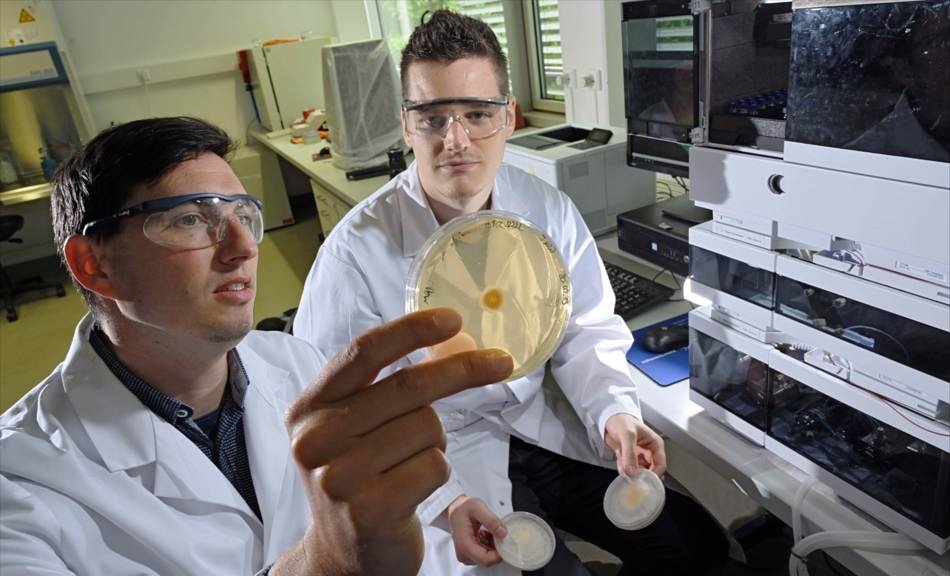Jun 24 2019
The fungus Mortierella alpina thrives in the soil and likes to stay cool. It belongs to the zygomycetes type, mainly exists in arctic or alpine habitats, and grows ideally at temperatures of 10 °C to 15 °C.
 Dr Markus Greßler (l.) and Florian Baldeweg. (Image credit: Jan-Peter Kasper/FSU)
Dr Markus Greßler (l.) and Florian Baldeweg. (Image credit: Jan-Peter Kasper/FSU)
The fungus has been used in biotechnology for the extensive production of polyunsaturated fatty acids like arachidonic acids, which are chiefly used as a dietary supplement in baby foods. However, M. alpina can be much more useful: a team of researchers from the Institute of Pharmacy at Friedrich Schiller University Jena has found out that this fungus even synthesizes other intriguing compounds.
In the renowned journal Organic Letters, the scientists, headed by Dr Markus Greßler, introduce a collection of surface-active peptides known as malpinins, synthesized by the fungus in large quantities.
Surfactants are elements used in washing liquids and laundry detergents. Florian Baldeweg, a Pharmacy PhD student and member of Greßler’s team, found out the compounds synthesized by the fungus upon attempting to purify peptides from Mortierella chromatographically.
Even very tiny amounts of malpinins form a head of foam on the top of the sample vial.
Florian Baldeweg, Pharmacy PhD Student, Friedrich Schiller University Jena
Baldeweg and Greßler have illustrated the structure of these compounds. This group of natural surfactants, which were unknown earlier, is known as malpinins. Their surfactant effect is much stronger than that of sodium dodecyl sulfate (SDS), which is the main ingredient in various common detergents.
Transporting Active Substances Through Biomembranes
However, the Jena scientists do not intend to use the natural surfactants to create new cleaning agents. “We want to test whether their properties could make the malpinins useful in pharmacology,” explained Greßler. This is due to the fact that surfactants not just promote a mixture of oil and water. “Biological membranes, which mainly consist of fatty acids, could be made permeable to pharmaceutical drugs,” added Greßler.
This could allow pharmaceutical substances to be transported through cell membranes. Greßler and Baldeweg want to test the malpinins to determine their pharmaceutical potential, together with colleagues from the Institute of Pharmacy of Friedrich Schiller University who work with Prof. Dagmar Fischer.
Lower Fungi Underestimated as Reservoir for Natural Products
The finding of the natural products in M. alpina is also intriguing since to date, lower fungi like the zygomycetes have obtained little interest as synthesizers of secondary metabolites, in contrast to higher fungi like Aspergillus species. Greßler anticipates that this scenario will now change: “Studies on the genome of M. alpina have shown that the fungus can produce many more natural products, and the malpinins are just one small group of them.”